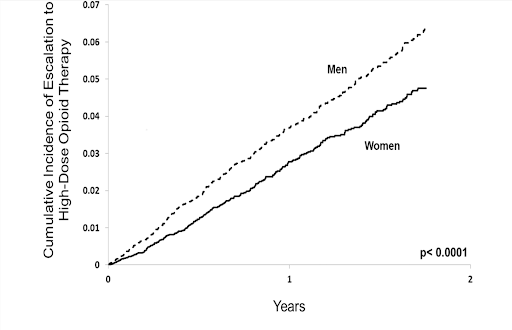Sex Differences in Opioid Overdose
While opioid overdose remains a national crisis in many countries such as the United States and Canada, certain demographics consistently report higher rates of opioid overdose. This could be a result of various factors including socioeconomic status, accessibility to pain treatments, and biases in the healthcare system. The exact differences of opioid overdose between males and females are yet to be established, due to the significant gaps in our knowledge of the relevant social determinants of health.
In a study conducted by Mason et al., researchers recorded the disparities in death rates due to opioid overdose in the U.S. from 1999 to 2019 and found that among residents aged 55 to 64, 58.98% of deaths were men and 41.01% were women (Mason et al., 2022). This difference of nearly 18% is unlikely to be arbitrary. Despite the lack of research in this interdisciplinary field , several research teams have attempted to uncover the potential reasons. In a 2021 literature review paper, it was analyzed that women, in general, were more likely than men to be exposed to benzodiazepine, antipsychotic, and antidepressant drug classes (Wightman et al., 2021). This suggests that a higher rate of opioid prescription and exposure may lead to females being more frequently administered opioid-involved treatments by the healthcare system (Wightman et al., 2021). These conclusions pose a key inquiry: why do males have a higher mortality rate due to opioid overdose if women are more likely to be prescribed opioids? A 2015 research published by Kaplovitch et al. proposed a hypothesis for this issue, with statistics displayed in Figure 1. The study conducted on Ontario populations revealed that male patients who were administered opioids were, generally, slightly older (Kaplovitch et al., 2015). In addition, they were documented to be more likely diagnosed with alcohol-use disorders, as well as less likely to receive antidepressants as a part of their treatment plan (Kaplovitch et al., 2015). Based on these findings, a potential cause of the sex disparity in opioid overdose could be the lower likelihood of male populations being administered opioid medications unless they are senior citizens or have additional health problems. As opioids have been discovered to possess immunosuppressive functions, this leads to a greater risk of opioid abuse in individuals (Plein & Rittner, 2017).
Figure 1. High-dose opioid therapy incidence of men and women. (Kaplovitch et al., 2015)
Nevertheless, many challenges have interfered with researchers’ attempts at investigating opioid-use sex differences. For example, a paper published in Current Opinion in Psychiatry states that some adversities could include geographic homogeneity, discrepancies in terminology in reporting opioid use, and the lack of health-related data available addressing sex and opioid overdose (Serdarevic et al., 2017). Furthermore, the same study suggests that more female patients would report chronic health conditions including pain and depression; whilst men are less likely to seek help from healthcare professionals and organizations (Serdarevic et al., 2017). One research article that gathered information regarding all previous gender-based studies on opioid use determined that gender biases in the healthcare system may be a contributing factor to the disparity. For instance, women are given sedatives more often than men in post-surgical pain management, while men typically receive analgesics instead (Bartley & Fillingim, 2013). Recent studies with technological innovation have found that females are considered to have greater intensity and unpleasantness of pain, and are hence more likely to be prescribed opioids (Bartley & Fillingim, 2013).
Figure 2. Picture of opioid drug pills. (Sanders, 2023)
In conclusion, there are many distinct factors, among which some remain unknown, that can influence the likelihood of opioid use, overdose, and mortality rate in different genders and sexes. Social and medical biases in the healthcare system play a crucial role that have led to the disparity of pain management intervention, especially opioid administration after surgery, in men and women. Moving forwards, there still exists large gaps that must be addressed in order to bridge the disparity in opioid administration and thus reduce opioid harm.
Works Cited
Bartley, E. J., & Fillingim, R. B. (2013). Sex differences in pain: A brief review of clinical and experimental findings. British Journal of Anaesthesia, 111(1), 52–58. https://doi.org/10.1093/bja/aet127
Kaplovitch, E., Gomes, T., Camacho, X., Dhalla, I. A., Mamdani, M. M., & Juurlink, D. N. (2015). Sex differences in dose escalation and overdose death during chronic opioid therapy: A population-based Cohort Study. PLOS ONE, 10(8). https://doi.org/10.1371/journal.pone.0134550
Mason, M., Soliman, R., Kim, H. S., & Post, L. A. (2022). Disparities by sex and race and ethnicity in death rates due to opioid overdose among adults 55 years or older, 1999 to 2019. JAMA Network Open, 5(1). https://doi.org/10.1001/jamanetworkopen.2021.42982
Plein, L. M., & Rittner, H. L. (2017). Opioids and the immune system – friend or foe. British Journal of Pharmacology, 175, 2717–2725. https://doi.org/https://www.ohsu.edu/sites/default/files/2021-01/LancioniC-W21-Plein_2017_opioids_immunity_review.pdf
Sanders, J. K. (2023). Picture of opioid bottle and pills. Pappalardo & Pappalardo. Retrieved March 20, 2023, from https://pappalardolaw.com/2023/02/ny-opioid-use-treatment-more-affordable/.
Serdarevic, M., Striley, C. W., & Cottler, L. B. (2017). Sex differences in prescription opioid use. Current Opinion in Psychiatry, 30(4), 238–246. https://doi.org/10.1097/yco.0000000000000337
Wightman, R. S., Perrone, J., Scagos, R., Hallowell, B. D., Krieger, M., Li, Y., McGregor, A. J., Nelson, L. S., & Marshall, B. D. L. (2021). Toxicological and pharmacologic sex differences in unintentional or undetermined opioid overdose death. Drug and Alcohol Dependence, 227, 108994. https://doi.org/10.1016/j.drugalcdep.2021.108994


